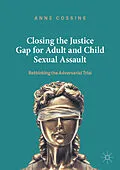This book examines the justice gap and trial process for sexual assault against both adults and children in two jurisdictions: England and Wales and New South Wales, Australia. Drawing on decades of research, it investigates the reality of the policing and prosecution of sexual assault offences - often seen as one of the 'hardest crimes to prosecute' - across two similar jurisdictions. Despite the introduction of many reform options, satisfactory outcomes for victims and the public are still difficult to obtain. Cossins takes a new approach by examining the structures of power within the trial process, to show how and at what points that process is weighted against complainants of sexual assault, in order to make thought-out suggestions for reform. She argues that this justice gap is a result of myths and misconceptions about rape which can be eliminated by a radical replacement of the adversarial system with a trauma-informed system. This book takes into consideration the psychological literature and speaks to students and academics across subjects including law, criminology, gender studies and psychology, and to practitioners in law and victim services, and policy-makers.
Autorentext
Anne Cossins is Professor of Law and Criminology in the Faculty of Law, University of New South Wales, Australia. She is the pre-eminent Australian expert on legal reform in the area of sexual assault and a scholar in theoretical criminology. She was the founder and Convenor of the National Child Sexual Assault Reform Committee in Australia and has been, and still is a member of various government committees, boards and councils dealing with sexual assault and domestic violence issues.
Inhalt
CHAPTER 1:INTRODUCTION
1.Introduction
2.What do we know about the prevalence of sexual assault?
(i)Australia
(ii)England and Wales
3.The importance of prevalence rates
4.Recorded Rates of Sexual Assault by Police
(i)Australia
(ii)England and Wales
5.Child sexual abuse: delayed reports to police
(i)The consequences of delayed disclosure of CSA
6.Attrition rates of sexual assault: the 'justice gap'
(i)England and Wales
(ii)Attrition of CSA cases
(iii)Summary of data in England and Wales
(iv)Australia: New South Wales
(v)Comparison of finalised sexual offences with other offences: what happens at trial?
(vi)The Royal Commission into Institutional Responses to Child Sexual Abuse
(vii)Summary: the similarities and differences between NSW and E&W
7.What to do about the attrition problem?
8.The contents of this book
CHAPTER 2: THE NATURE AND EFFECTS OF ADVERSARIALISM: JURY DECISION MAKING IN SEXUAL ASSAULT TRIALS
1. Introduction
2. Jury Behaviour: understanding sexual assault trials
(i)The majority effect
(ii)The leniency asymmetry effect
(iii)Leniency asymmetry effect: is there a difference between mock and real juries?
(iv)Severity or leniency effect: how do real juries actually behave?
(v)Systematic biases in jury decision-making
(vi)Is the leniency effect more pronounced in sexual assault cases because of jurors' adherence to rape myths?
CHAPTER 3: FACTORS THAT PREDICT OUTCOMES IN SEXUAL ASSAULT TRIALS
1.Introduction
2.Factors that predict outcomes in sexual assault trials: physical evidence
3.Factors that predict outcomes in sexual assault trials: other corroborating evidence
4.The impact of extra-legal factors on outcomes in sexual assault trials: victim, defendant and juror characteristics
5.The impact of the emotionality of the victim/complainant on case outcomes
6.The influence of victim gender, victim race and other extra-legal factors on case outcomes
7.Summary
CHAPTER 4: 'COMMONSENSE' OR 'LIFE EXPERIENCE': JURORS' PERCEPTIONS OF GUILT
1.Introduction
2.The effect of alcohol consumption on perceptions of guilt
3.What jurors do not know about the vulnerability of women and children to sexual assaultCHAPTER 5: 'NO MEANS YES AND YES MEANS ANAL': THE CULTURAL CLIMATE IN WHICH SEX OFFENCES ARE PROSECUTED
1.Introduction
2.Rape myth acceptance studies
(i)Prevalence of rape myths: general population surveys
(ii)Rape myth acceptance (RMA) studies
(iii)The factors influencing victim blame
(iv)The independent effects of victim and participant characteristics on victim blaming
(v)Investigating the independent effects of victim stereotypicality and gender stereotypicality
(vi)Summary
6. Interactions between offence, victim and perpetrator stereotypicality
7. Mock jurors' beliefs about victims of child sexual abuse
8. The heuristic-systematic processing model of juror decision-making
9.Summary: jury decision-making in sexual assault trials
CHAPTER 6: THE NATURE AND EFFECTS OF ADVERSARIALISM: SITES OF ACTIVATION FOR HEURISTIC REASONING PROCESSES
1. Background: the role of evidence and procedural laws in sexual assault trials
2. Activation statements in sexual assault trials
(i) Prosecution and defence opening addresses
(ii) Jurors' narrative framework
(iii) The story model and pre-decisional distortion
CHAPTER 7:MODERNISATION OF THE SUBSTANTIVE LAW OF CONSENT
<...
Titel
Closing the Justice Gap for Adult and Child Sexual Assault
Untertitel
Rethinking the Adversarial Trial
Autor
EAN
9781137320513
Format
E-Book (pdf)
Hersteller
Veröffentlichung
21.10.2020
Digitaler Kopierschutz
Wasserzeichen
Dateigrösse
6.37 MB
Anzahl Seiten
719
Unerwartete Verzögerung
Ups, ein Fehler ist aufgetreten. Bitte versuchen Sie es später noch einmal.
